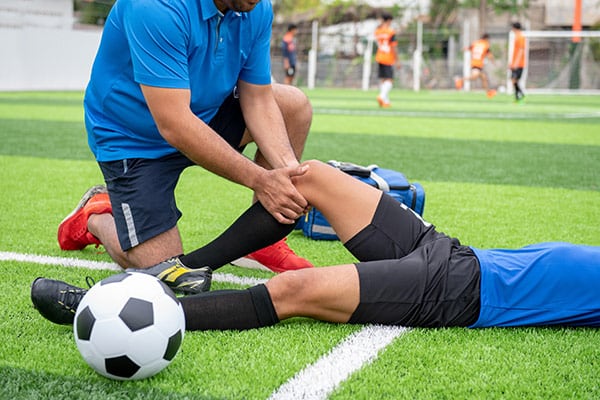September 15, 2016

Typical knee problems fall into two categories:
The first category is traumatic injuries to the knee, or those strains and twists that happen on the athletic field. The second category are those knee problems that result from overuse of the knee —the wear and tear that comes with age and mileage.
The typical acute injuries we see to the knee are strained and torn ligaments. A common injury in the athlete is the torn anterior cruciate ligament (ACL). Over 95,000 people in the US had ACL injuries last year. ACL injuries actually occur more more often in women than men.
The ACL is one of the major ligaments that connects and maintains the stability of the knee joint. the knee joint. The ACL helps keep the knee stable. The knee is a very complicated joint, unlike some of the other joints in the body where the movements of that joint are actually fairly simple. The knee is not actually a simple hinge joint as one may think. The knee slides and rolls minutely in different directions as you bend or straighten your knee and the myriad of ligaments control all those subtle motions in a complex orchestration of movement. These minute motions are critical to a normal, long-lasting knee. When an athlete injures his or her knee, and some of these ligaments are disconnected and moments disrupted, regaining those subtle complex relationships of surfaces upon one another can be a very entailed endeavor.
The ACL works in concert with all the ligaments and cartilage to provide stability and longevity.
People who have injured their ACL will often complain of an unstable knee or a knee that buckles. It is often referred to as a “trick knee.” In those cases, we do an operation known as ACL reconstruction. It’s a very common operation these days with younger athletes, given the demands that sports put on these young athletes. Our goal is to get patients back to one hundred percent of what they were doing pre-injury. Click through to learn more about ACL reconstruction.
How do I know I might have an ACL injury?
- An ACL tear usually occurs as a the result of a twisting or hyperextension injury. Getting tackled or stepping in a hole are common scenarios. Although the amount of force is usually substantial, sometimes it is surprising how small the injury is that tears the ACL.
- People often hear or feel a “pop” in the knee.
- The knee often swells and it might be difficult to put weight on the leg.
Immediate treatment: RICE: Rest the knee, Ice the knee, Compress the Knee (ace bandage or knee brace) and Elevate the knee to minimize swelling. Take anti-inflammatories and seek professional treatment from your sports medicine specialist.
When does an ACL injury require surgery?
This is an individual decision. Activity level is the most important factor. The degree of instability or looseness is the other factor. Younger, active individuals generally require a functioning ACL and therefore surgery to reconstruct the torn ligament is recommended. The same is true with physical laborers and active individuals of all ages, particularly if jumping and cutting activities are expected. There are many people who can live happily with an ACL-deficient knee. You should have this discussion with your doctor.
To learn more: Anterior Cruciate Ligament (ACL) Injuries patient info from the American Academy of Orthopaedic Surgeons page
